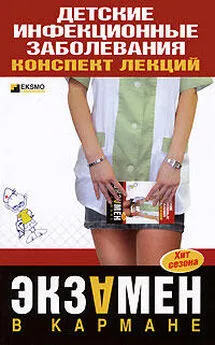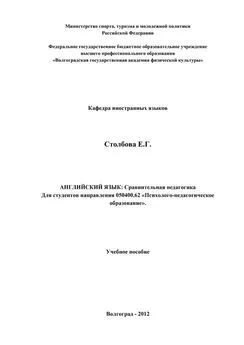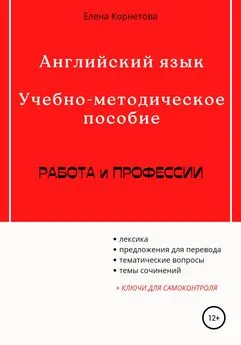Елена Беликова - Английский язык для медиков: конспект лекций
- Название:Английский язык для медиков: конспект лекций
- Автор:
- Жанр:
- Издательство:Конспекты, шпаргалки, учебники «ЭКСМО»b4455b31-6e46-102c-b0cc-edc40df1930e
- Год:2007
- Город:Москва
- ISBN:978-5-699-20181-5
- Рейтинг:
- Избранное:Добавить в избранное
-
Отзывы:
-
Ваша оценка:
Елена Беликова - Английский язык для медиков: конспект лекций краткое содержание
Представленный вашему вниманию конспект лекций предназначен для подготовки студентов медицинских вузов к сдаче экзамена. Книга включает в себя полный курс лекций по английскому языку, написана доступным языком и будет незаменимым помощником для тех, кто желает быстро подготовиться к экзамену и успешно его сдать.
Английский язык для медиков: конспект лекций - читать онлайн бесплатно ознакомительный отрывок
Интервал:
Закладка:
Запомните следующие застывшие словосочетания.
In a loud voice In a low voice In an angry voice In a thin voice
Заполните пропуски, где необходимо.
1. She shouted in. low voice.
2. He told us the poem in. loud voice.
3. The children asked ice-cream in. thin voice.
4. The teacher cried at the pupils in. angry voice.
5. Bill Robins was… very rich man.
6. He was. richest man in. village.
7. Pete is… tallest boy in our class.
8. Nick is… shortest boy, but he is very strong.
9. He is… stronger than many boys who are taller than he.
10. I think Nick is… strongest boy in class.
Перед превосходной степенью прилагательных употребляется определенные артикль.
E. g. Asia is the largest continent.
My brother is the best pupil in his class.
Вставьте артикль, где необходимо.
1. Bill Robins was… very rich man. He was… richest man in… village.
2. Pete is… tallest boy in our class. Nick is… shortest boy, but he is very strong.
3. He is… stronger than many boys who are taller than he.
4. I think Nick is… strongest boy in class.
5. Granny often tells us… long stories. Today her story was still… longer.
6. It was… longest story. She began telling it after… dinner and finished it before… supper.
7. But… story was very interesting. I think it was… most interesting of Granny's stories.
8. Which was… most difficult exercise in. test-paper?
9. Which is… best season of the yea?
10. February is… shortest month of the year.
Answer the questions.
1. How are arteries classified?
2. What do large elastic conducting arteries include?
3. What is the tunica intima composed of?
4. What does an internal elastic membrane mark?
5. Is the tunica media thick?
6. Is the tunica adventitia a longitudinally oriented collection of col-lagenous bundles?
7. With what do the tunica adventitia associated?
8. What are muscular distributing arteries?
9. Up to how many layers of smooth muscle may occur?
10. What is the media composed of?
Make the sentences of your own using the new words (10 sentences).
Find the definite and indefinite articles in the text.
ЛЕКЦИЯ № 19. Capillaries
Capillaries are thin-walled, narrow-diameter, low-pressure vessels that generally permit easy diffusion across their walls. Most capillar ies have a cross-sectional diameter of 7-12 mm. They are composed of a simple layer of endothelium, which is the lining of the entire vas cu-lar system, and an underlying basal lamina. They are attached to the surrounding tissues by a delicate reticulum of collagen. Associated with these vessels at various points along their length are specialized cells called pericytes. These cells, enclosed within their own basal lamina, which is continuous with that of the endothelium, contain contractile proteins and thus may be involved in the control of capillary dynamics. They may also serve as stem cells at times of vascular repair. Capillaries are generally divided into three types, according to the structure of their endothelial cell walls.
Continuous (muscular, somatic) capillaries are formed by a single uninterrupted layer of endothelial cells rolled up into the shape of a tube and can be found in locations such as connective tissue, muscle, and nerve.
Fenestrated (visceral) capillaries are characterized by the presence of pores in the endothelial cell wall. The pores are covered by a thin diaphragm (except in the glomeruli of the kidney) and are usually encountered in tissues where rapid substance interchange occurs (e. g., kidney, intestine, endocrine glands).
Sinusoidal capillaries can be found in the liver, hematopoietic and lymphopoietic organs, and in certain endocrine glands. These tubes with discontinuous endothelial walls have a larger diame ter than other capillaries (up to 40 mm), exhibit irregular cross-sec tional profiles, have more tortuous paths, and often lack a con tinuous basal lamina. Cells with phagocytic activity (macrophages) are present within, or just subjacent to, the endothelium.
New words
capillaries – капилляры
to thin-walled – окруженный тонкой стеной
narrow-diameter – узкий диаметр
low-pressure – низкое давление
that – тот
generally – главным образом
permit – разрешение
easy – легкий
diffusion – распространение
cross-sectional – поперечный
to be composed – быть составленным
simple – простой
endothelium – эндотелий
lining – выравнивание
entire – весь
vas cular – сосудистый
underlying – лежащий в основе
basal – основной
lamina – тонкая пластинка
Правила употребления артикля с географическими названиями.
Определенный артикль употребляется перед названиями рек, каналов, морей, заливов, проливов, океанов, архипелагов, горных цепей.
Артикль не употребляется перед названиям озер, гор, островов, континентов, городов, стран. Исключения:
the United States of America
the United Kingdom of Great Britain and Northern Ireland the Netherlands the Ukraine the Crimea the Congo
Answer the questions.
1. Describe capillaries: how do they like?
2. What diameter do the most capillaries have?
3. What are the capillaries composed of?
4. Where are the capillaries attached to?
5. What are pericytes?
6. What do pericytes contain?
7. Where can pericytes be involved?
8. Where can sinusoidal capillaries be found?
9. What diameter have sinusoidal capillaries?
10. With help of what are continuous (muscular, somatic) capillaries formed by?
Make the sentences of your own using the new words (10 sentences).
Find the definite and indefinite articles in the text.
ЛЕКЦИЯ № 20. Veins
Veins are low-pressure vessels that have larger lumina and thinner walls than arteries. In general, veins have more collagenous connec ti-ve tissue and less muscle and elastic tissue than their arterial coun ter-parts. Although the walls of veins usually exhibit the three layers, they are much less distinct than those of the arter ies. Unlike arteries, veins contain one-way valves composed of exten sions of the intima that prevent reflux of blood away from the heart. Veins can be divided into small veins or venules, medium veins, and large veins.
Venules are the smallest veins, ranging in diameter from approxi mately 15-20 mm (post-capillary venules) up to 1-2 mm (small veins). The walls of the smaller of these are structurally and func tio-nally like those of the capillaries; they consist of an endothelium surrounded by delicate collagen fibers and some pericytes. In those vessels of increased diameter, circularly arranged smooth muscle cells occur surrounding the intima layer, but unlike in the small arteries, these cells are loosely woven and widely spaced. Venules are important in inflammation because their endothelial cells are sensitive to his-tamine released by local mast cells. This causes endothelial cells to contract and separate from each other, exposing a naked basement membrane. Neutrophils stick to the exposed collagen and extravasate (i. e., move out into the connective tissue). Histamine also causes local arterioles to relax, affect ing a rise in venous pressure and increased leaking of fluid. This produces the classic signs of inflammation: redness, heat, and swelling.
Medium veins in the range of 1-9 mm in diameter have a well – developed intima, a media consisting of connective tissue and loosely organized smooth muscle, and an adventitia (usually the thickest layer) composed of collagen bundles, elastic fibers, and smooth muscle cells oriented along the longitudinal axis of the vessel. Venous valves are sheet-like outfoldings of endothelium and underlying connective tissue that form flaps to permit unidi rectional flow of blood.
Large veins, such as the external iliac, hepatic portal, and vena ca-vae, are the major conduits of return toward the heart. The intima is similar to that of medium veins. Although a network of elastic fibers may occur at the boundary between the intima andmedia, a typical internal elastic membrane as seen in arteries is not present. A tunica media may or may not be present. If pre sent, smooth muscle cells are most often circularly arranged. The adventitia is the thickest layer of the wall and consists of elastic fibers and longitudinal bundles of collagen. In the vena cava, this layer also contains well-developed bundles of longitudinally oriented smooth muscle.
New words
vein – вена
low-pressure – низкое давление
to have – иметь
collagenous – коллагеновый
elastic – упругий
although – хотя
walls – стенкы
coun terparts – копии
unlike – в отличие от
exten sions – расширения
intima – интима
to prevent – предотвратить
reflux – рефлюкс
sheet-like – подобный листу
inflammation – воспламенение
because – потому что
longitudinal – продольный
flaps – откидные створки
external – внешний
iliac – подвздошный
hepatic – печеночник
Запомните следующие застывшие словосочетания:
To have a good time From _ morning till night All _ day long
A lot of
Перед названиями университетов артикль не употребляется.
E. g. I shall study at _ St. Petersburg University.
My grandfather graduated from _ Oxford University
Вставьте артикль, где необходимо.
1. Did you have… good time in the country?
2. Oh yes… weather was fine.
3. We were out of… doors from… morning till… night.
4. We played… football,… volley-ball and… other games.
5. We саше… home late at… night and went to… bed at once.
6. Look at… clock! It is… quarter past ten. Go to… bed at once.
7.. sun rises in.east and sets in. west.
8. We spent last summer in. Ukraine.
9. We often went to. wood and gathered lot of… mushrooms.
10. My friend likes to play… chess. He is ready to play… chess all… day long.
11. Willi comes from… very old country on… Nile. It is called… Ethiopia.
12… Ethiopia is… beautiful mountainous country.
13. Nick is… young man. He wants to become… engineer.
14. Very often in… evening his new friends and he walk about… city talking about their native countries.
15. Marina lives in. Ukraine.
16. She lives in… small village near… Kiev.
Читать дальшеИнтервал:
Закладка:










